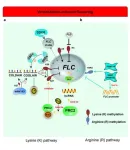Powering AI could use as much electricity as a small country
2023-10-10
(Press-News.org) Artificial intelligence (AI) comes with promises of helping coders code faster, drivers drive safer, and making daily tasks less time-consuming. But in a commentary published October 10 in the journal Joule, the founder of Digiconomist demonstrates that the tool, when adopted widely, could have a large energy footprint, which in the future may exceed the power demands of some countries.
“Looking at the growing demand for AI service, it’s very likely that energy consumption related to AI will significantly increase in the coming years,” says author Alex de Vries (@DigiEconomist), a Ph.D. candidate at Vrije Universiteit Amsterdam.
Since 2022, generative AI, which can produce text, images, or other data, has undergone rapid growth, including OpenAI’s ChatGPT. Training these AI tools requires feeding the models a large amount of data, a process that is energy intensive. Hugging Face, an AI-developing company based in New York, reported that its multilingual text-generating AI tool consumed about 433 megawatt-hours (MWH) during training, enough to power 40 average American homes for a year.
And AI’s energy footprint does not end with training. De Vries’s analysis shows that when the tool is put to work—generating data based on prompts— every time the tool generates a text or image, it also uses a significant amount of computing power and thus energy. For example, ChatGPT could cost 564 MWh of electricity a day to run.
While companies around the world are working on improving the efficiencies of AI hardware and software to make the tool less energy intensive, de Vries says that an increase in machines’ efficiency often increases demand. In the end, technological advancements will lead to a net increase in resource use, a phenomenon known as Jevons’ Paradox.
“The result of making these tools more efficient and accessible can be that we just allow more applications of it and more people to use it,” de Vries says.
Google, for example, has been incorporating generative AI in the company’s email service and is testing out powering its search engine with AI. The company processes up to 9 billion searches a day currently. Based on the data, de Vries estimates that if every Google search uses AI, it would need about 29.2 TWh of power a year, which is equivalent to the annual electricity consumption of Ireland.
This extreme scenario is unlikely to happen in the short term because of the high costs associated with additional AI servers and bottlenecks in the AI server supply chain, de Vries says. But the production of AI servers is projected to grow rapidly in the near future. By 2027, worldwide AI-related electricity consumption could increase by 85 to 134 TWh annually based on the projection of AI server production.
The amount is comparable to the annual electricity consumption of countries such as the Netherlands, Argentina, and Sweden. Moreover, improvements in AI efficiency could also enable developers to repurpose some computer processing chips for AI use, which could further increase AI-related electricity consumption.
“The potential growth highlights that we need to be very mindful about what we use AI for. It’s energy intensive, so we don't want to put it in all kinds of things where we don’t actually need it,” de Vries says.
###
The author declares no competing interest.
Joule, de Vries, A.: “The growing energy footprint of artificial intelligence.” https://www.cell.com/joule/fulltext/S2542-4351(23)00365-3
Joule (@Joule_CP), published monthly by Cell Press, is a new home for outstanding and insightful research, analysis, and ideas addressing the need for more sustainable energy. A sister journal to Cell, Joule spans all scales of energy research, from fundamental laboratory research into energy conversion and storage to impactful analysis at the global level. Visit http://www.cell.com/joule. To receive Cell Press media alerts, contact press@cell.com.
END
ELSE PRESS RELEASES FROM THIS DATE:
2023-10-10
Adulteration is a bitter truth in the sweet world of honey. As consumers seek nature’s nectar for its purity and health benefits, a shadowy industry taints this golden elixir with hidden additives, most commonly water.
Standard detection methods of honey adulteration are expensive, and either have complicated operation methods or low detection accuracy.
In Review of Scientific Instruments, from AIP Publishing, a team of scientists from the Nanjing University of Aeronautics and Astronautics ...
2023-10-10
About The Study: A multilevel primary care intervention that included electronic health record reminders and patient outreach with or without patient navigation improved timely follow-up of overdue abnormal cancer screening test results for breast, cervical, colorectal, and lung cancer.
Authors: Steven J. Atlas, M.D., M.P.H., of Massachusetts General Hospital in Boston, is the corresponding author.
To access the embargoed study: Visit our For The Media website at this link https://media.jamanetwork.com/
(doi:10.1001/jama.2023.18755)
Editor’s Note: Please see the article for additional information, including ...
2023-10-10
Long-term exposure to low-frequency noise can cause numerous health problems, but the solution may be found in an unexpected object, a pingpong ball. Conventionally thought of as the hollow plastic balls that speed through the air during a fast-tempo game of table tennis, with a few modifications, pingpong balls can help absorb the city din.
Low-frequency noise is ubiquitous in cities, near roads, and by airports. Though potentially heard as background in the acoustic landscape, it can trigger earaches, respiratory impairment, irritability, and other ...
2023-10-10
About The Study: This study of middle-aged Chinese surgery patients found subjective cognitive and short-term memory impairment within 12 months after both cardiac and noncardiac surgery, with multiple identified risk factors, underscoring the potential of preoperative psychological interventions and optimized perioperative management for postoperative cognitive impairment prevention.
Authors: Huan Song, M.D., Ph.D., and Qian Li, M.D., of Sichuan University in Chengdu, China, are the corresponding authors.
To access the embargoed study: Visit our For The Media ...
2023-10-10
About The Study: This cross-sectional study found that most survey respondents who gave birth between June and December 2020 did not use prenatal telehealth, and a personal preference for in-person care was the most common reason. Patients’ preferences should influence how prenatal telehealth, which has both benefits and drawbacks, is incorporated into their care.
Authors: Rebecca A. Gourevitch, Ph.D., of the University of Maryland in College Park, is the corresponding author.
To access the embargoed study: Visit our For The Media website at this link https://media.jamanetwork.com/
(doi: ...
2023-10-10
Discharged in large quantities by textile, cosmetic, ink, paper and other manufacturers, dyes carry high-toxicity and can bring potential carcinogens to wastewater. It’s a major concern for wastewater treatment—but researchers in Drexel University’s College of Engineering may have found a solution, using a tiny nanofilament.
A study lead Michel Barsoum, Ph.D., Distinguished University professor in the College of Engineering, and his team, including researchers from Drexel’s College of Arts and Sciences, found that a ...
2023-10-10
Recognized as a pivotal developmental transition, flowering marks the continuation of a plant's lifecycle. Flowering time determines the length of plant reproductive period and environmental adaptability. The correct flowering time is very significant for plants to reproduce fruit successfully and is controlled by environment and endogenous signals. Vernalization and photoperiod are the two main flowering pathways orchestrating a large number of floral signals. Methylation is one of the most important epigenetic modifications, which is involved in many key plant growth and development events. Methylation, including histone methylation, DNA methylation ...
2023-10-10
Engineers at the University of California San Diego have developed electronic “stickers” that measure the force exerted by one object upon another. The force stickers are wireless, run without batteries and fit in tight spaces. That makes them versatile for a wide range of applications, from arming robots with a sense of touch to elevating the immersive experience of VR and AR, making biomedical devices smarter, monitoring the safety of industrial equipment, and improving the accuracy and efficiency of inventory management in warehouses.
They could be used, for example, in knee implants to measure the forces that implants exert on the joint. ...
2023-10-10
COLUMBUS, Ohio – In our increasingly polarized society, more people may find themselves in a workplace where they are one of the few conservatives or few liberals around.
A new study found that those whose values – political or otherwise – don’t match the majority in their organization felt they received less respect and as a result were less engaged at work. Moreover, their co-workers noticed their lack of engagement.
“It is a real issue that organizations face,” said Tracy Dumas, lead author of the study and associate professor of management and human resources at The Ohio State University’s ...
2023-10-10
Background
Since Mercury is the closest planet to the Sun among the solar system planets, it is strongly influenced by the solar wind, a high-speed (several hundred km/s) stream of plasma blowing from the Sun. Explorations of Mercury was first carried out by the Mariner 10 spacecraft in 1974 and 1975, which revealed that Mercury has a magnetic field, and thus a magnetosphere, similar to that of Earth. In the 2000s, the MESSENGER spacecraft provided a detailed picture of the Mercury's magnetic field and magnetosphere, and revealed that Mercury's magnetic field center is shifted northward from the planet’s center by approximately ...
LAST 30 PRESS RELEASES:
[Press-News.org] Powering AI could use as much electricity as a small country




